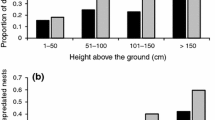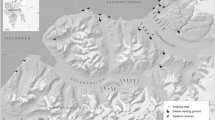Abstract
Mixed-species nesting associations have been reported for many birds. However, few studies have shown that one species specifically chooses to nest close to another in order to obtain a direct benefit and only two studies have managed to adequately test the predator protection hypothesis for such associations. Here we demonstrate a nesting association between Bullock's orioles (Icterus galbula bullockii) and yellow-billed magpies (Pica nuttalli). The evidence indicates that this is an active association in which, given a choice of suitable habitat areas in which to nest, orioles choose those areas that contain magpie nests. Oriole nests associated with magpie nests have a significantly reduced predation rate compared to those without associated magpie nests. This suggests that orioles prefer to nest near to magpies and that this preference has evolved due to the protection provided by neighbouring magpies. The nesting association results in the clumping of oriole nests around magpie nests, and therefore provides a possible explanation for the semi-colonial nature of Bullock's orioles.
Similar content being viewed by others
Author information
Authors and Affiliations
Additional information
Received: 23 November 1998 / Received in revised form: 25 May 1999 / Accepted: 30 May 1999
Rights and permissions
About this article
Cite this article
Richardson, D., Bolen, G. A nesting association between semi-colonial Bullock's orioles and yellow-billed magpies: evidence for the predator protection hypothesis. Behav Ecol Sociobiol 46, 373–380 (1999). https://doi.org/10.1007/s002650050632
Issue Date:
DOI: https://doi.org/10.1007/s002650050632




